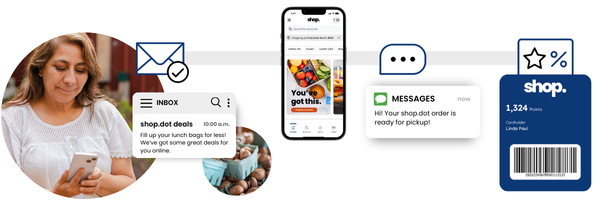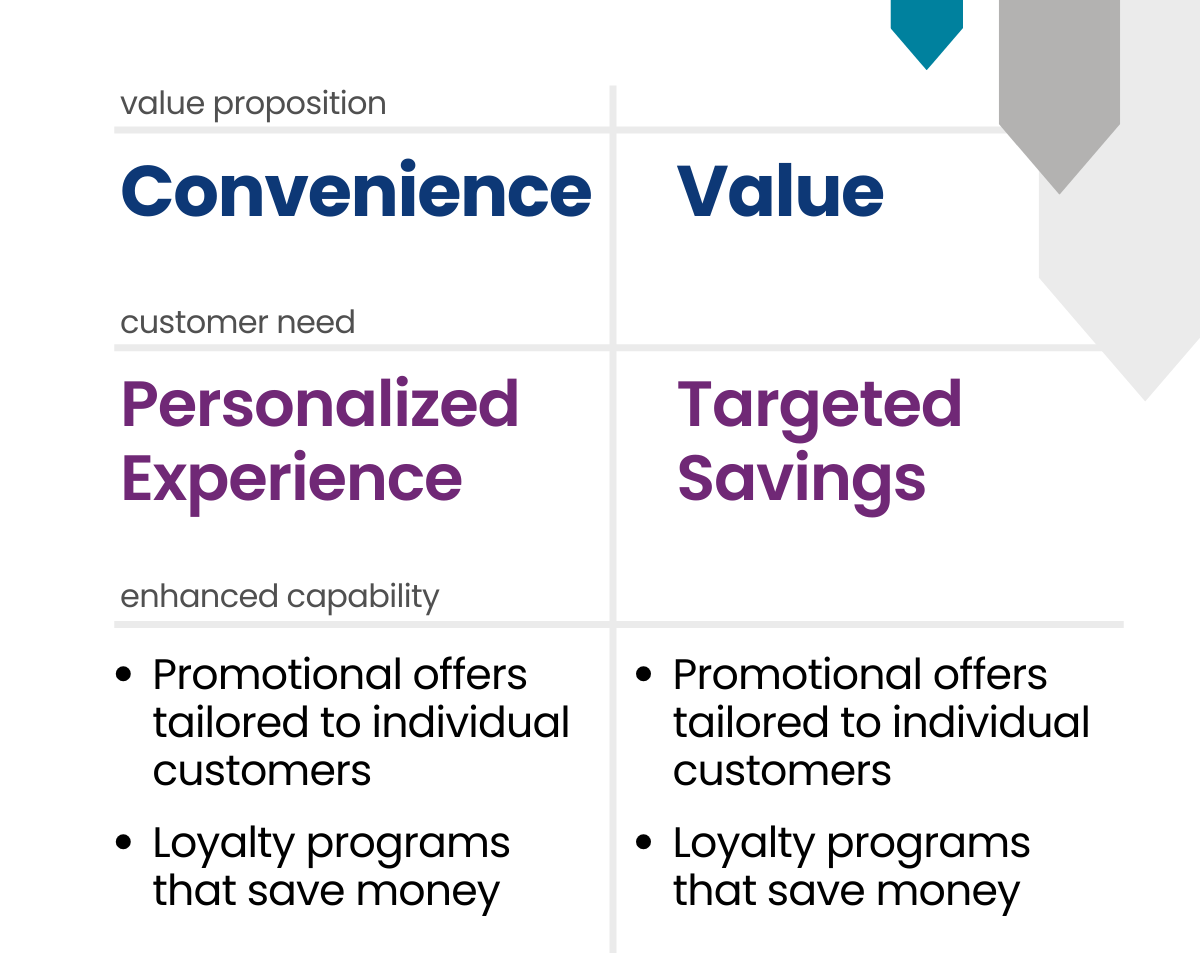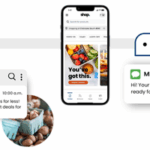This article was originally published on January 18, 2022. It was updated on May 21, 2025.
Gone are the days of one-size-fits-all offers.
As online grocery shopping continues to grow, the ability to tailor each customer’s experience with your store could be the difference between frequent checkouts full of sales and an abandoned cart.
Today’s online shoppers have high expectations. Consumer behavior data suggests customers want every interaction with a retailer to feel like it was made just for them. To meet this expectation, grocery retailers must lean into the latest technology and provide their customers with a personalized shopping experience.
An effective personalization strategy does more than boost incremental sales growth potential—it helps grocers deepen connections with their customers and position their businesses for sustained growth.
The stronger the level of grocery personalization maturity being offered, the more likely grocers are to retain their customers and create higher lifetime values from them.
To get there, grocers must begin with a foundational approach to gathering and utilizing data, managing customer relationships, and ensuring that every touchpoint with the customer is personalized and engaging. That may sound daunting, but as we’ll reveal throughout this article today’s scaled, advanced personalization capabilities make it possible.
Here’s a breakdown of the five critical strategies necessary to profitably implement personalization strategies for your grocery business.
1. Collect and Consolidate Customer Data
To create meaningful and highly targeted personalization, grocers must first understand their customers on an individual level.
This begins with data—specifically, first-party data collected directly from customer interactions. Within point-of-sale systems, loyalty programs, and online platforms, grocers already have access to an abundance of information, including transaction records of past purchases, product details, pricing and promotions, feedback, and browsing behavior.
However, data collection alone is not enough.
For this wealth of information to drive one-to-one personalization effectively, it must be unified into a centralized system that provides a holistic view of each customer. By consolidating data into a single, clean repository, grocers can create the foundation for actionable insights.
Once unified, this data becomes a powerful tool. Advanced technologies such as artificial intelligence (AI) and machine learning (ML) can analyze transaction logs and shopping behavior to uncover purchasing patterns, preferences, and shopping cycles.
Using this insight, the grocer can send a personalized reminder or offer a discount just before the next purchase cycle, providing convenience and relevance that resonates with the customer.
A Warning to Grocery Retailers: Beware of Third-Party Reliance
It’s worth mentioning at this point that many regional grocers rely on third-party platforms like Instacart to fulfill delivery orders.
While this may offer immediate convenience and access to a large marketplace, it often comes at the cost of losing control over valuable first-party customer data. These platforms retain much of the data they generate, limiting your ability to craft personalized shopping experiences and build strong customer relationships.
To truly excel in personalization, grocers must prioritize owning and managing their customer data directly. This not only enables tailored engagement but also safeguards the foundation for long-term loyalty and growth.
2. Segment Customers and Deliver Targeted Offers
Once grocers have consolidated their data into a unified system, the next step is to use that data to segment customers into meaningful groups.
By identifying patterns and shared traits—such as shopping habits, purchase frequency, or lifecycle stage—grocers can create highly personalized campaigns that resonate with each segment’s unique needs and preferences.
Segmentation allows grocers to move beyond broad, generalized promotions and deliver offers that are tailored to specific customer groups.

For example, new grocery customers can be welcomed with a special discount to encourage their first purchase, while lapsed customers can be enticed back with exclusive promotions on their favorite products.
By leveraging advanced analytics and predictive tools, grocers can create hyper-targeted campaigns that reflect not just what customers have purchased in the past but what they are likely to need in the future. This precision drives deeper customer connections and increases engagement, helping grocers turn occasional shoppers into loyal advocates.
Utilize The Latest Grocery Industry Technology
Once segmented, customers can be targeted through dynamic content across multiple channels.
Grocery executives need not worry about additional costs for this. The latest eCommerce technology allows grocers to easily do this without additional coding or specialized technical expertise.
Advanced platforms enable grocers to automate personalized campaigns across websites, mobile apps, email, and SMS, ensuring seamless delivery of relevant content to each customer at the right time.
For instance, websites and mobile apps can feature content blocks that adapt in real time to showcase products, recipes, or deals tailored to individual preferences based on past purchases. A loyal customer might see a recipe featuring items they frequently purchase, while a lapsed customer might be presented with a special promotion on a product they used to buy regularly.
Email and SMS campaigns can also be personalized based on segment behavior, with timely messages that reflect each customer’s needs. For example, a busy parent might receive a reminder about their weekly grocery order along with an offer for kid-friendly snacks.
How Targeted Offerings Strengthen Customer Loyalty
When grocers deliver offers and content that feels relevant and timely like this, customers are more likely to engage and convert. This approach not only drives sales but also strengthens trust and loyalty, as customers feel understood and valued.
Through effective segmentation and targeted campaigns, grocers can unlock the full potential of their customer data, creating experiences that are personalized, impactful, and ultimately, profitable.
3. Build a Comprehensive Engagement Strategy with a Personalized Loyalty Program
After consolidating data, segmenting customers, and issuing targeted savings timed to purchase cycles, the next step is to solidify these connections with a personalized loyalty program.
A loyalty program acts as the glue that binds all your grocery personalization efforts together, transforming one-off interactions into an ongoing relationship with your customers.
A well-designed loyalty program is more than nominal benefits or a way to offer points and discounts—it is the foundation of an effective customer engagement strategy. By tailoring rewards to individual preferences and continuously refining the program based on feedback and performance data, grocers can deepen relationships, boost retention, and increase lifetime customer value—which should be the objective of any loyalty program.
Why Loyalty Programs Matter
Fostering customer loyalty depends on more than transactional benefits.
Grocery retailers need to create a sense of recognition and appreciation with their programs that acknowledge each customers’ unique shopping habits. This level of personalization strengthens loyalty and increases the likelihood of repeat purchases.

How Technology Enhances Loyalty Programs
To do this effectively, grocers need advanced loyalty management platforms that create and optimize personalized programs. These systems allow for:
- Dynamic reward structures that adapt to customer behavior in real time.
- Automated tracking of member activity, ensuring accurate and timely delivery of rewards.
- Data-driven insights that help fine-tune program features for maximum impact.
Loyalty programs that prioritize personalization and adaptability transform customer relationships from transactional to meaningful. By consistently rewarding customers in ways that reflect their preferences and shopping habits, grocers can turn occasional shoppers into lifelong advocates while driving long-term business growth.
4. Connect Online and In-store Experiences
With a personalized loyalty program in place, the next step is to ensure your personalization efforts extend seamlessly across all channels.
Customers interact with your brand in various ways—through websites, mobile apps, social media, email, and in-store visits. A truly effective approach to grocery personalization will tie all of these touchpoints together, creating a unified and personalized experience that resonates with customers wherever they engage with your business.

Why a Unified Customer Experience Matters
Today’s shoppers don’t view their interactions with a retailer as a separate online or in-store experience—they see one brand.
As a result, grocers need to deliver personalized deals and relevant content consistently across all channels.
A customer who buys groceries in-store should benefit from follow-up offers via email or a mobile app that align with what was purchased. Combining data from both online and in-store purchases ensures that loyalty programs and marketing efforts are cohesive and reflect the customer’s full journey.
Key Elements of Unified Personalization
1. Integrate Online and In-store Data
We’ve already discussed how successful personalization efforts begin by unifying customer data from all touchpoints. That unification also extends to customer interactions.
By consolidating online purchase data, in-store transaction records, and loyalty program interactions, grocers can create a comprehensive view of each customer’s behavior—across all channels in which they shop.
2. Diversify Communication Channels
Don’t limit your outreach to a single platform. Use email, mobile apps, SMS, social media, and even in-store displays to engage customers with personalized messages.
3. Ensure Consistency Across Channels
Customers expect a seamless experience, and that includes seeing consistent information across all channels. If a customer is notified of a discount on their app, the same offer should be reflected in-store or through their loyalty account.
The Benefits of a Unified Approach
Unified personalization fosters stronger connections with customers by meeting them where they are and providing relevant, timely engagement. It increases loyalty program participation, boosts engagement rates, and ensures customers see value in every interaction with your brand.
By integrating online and in-store data and diversifying communication channels, grocers can create a cohesive and engaging experience that drives long-term customer loyalty and satisfaction.
5. Create a Virtuous Cycle Through Data-driven Feedback for Your Grocery Business
With multi-channel personalization in place, the final step is to establish a data-driven feedback loop that ensures your grocery personalization efforts stay relevant, effective, and adaptive to evolving customer needs.
Grocery executives know that there are few things in this industry in which you can set and forget. And personalization is no different. It requires ongoing refinement based on performance metrics and customer feedback.
A feedback loop helps grocers monitor the effectiveness of their personalization by analyzing data from customer interactions across all channels. This allows you to pinpoint what works, identify areas for improvement, and make informed adjustments to campaigns, loyalty programs, and communication strategies.
For example, if data shows that customers are frequently engaging with offers sent via email but less so with app notifications, you can recalibrate your approach to strengthen underperforming channels.
Key Components of a Data-driven Feedback Loop
You’ll gather a deeper understanding of personalization’s impact on business and technology functions by:
1. Monitoring Key Performance Indicators (KPIs)
Tracking essential metrics provides a clear picture of how personalization efforts are impacting your business and where adjustments may be needed:
- Customer lifetime value
- Customer retention rates
- Average order value
- Order frequency
- Loyalty program participation
- Engagement rates for campaigns across email, SMS, and other channels.
2. Leveraging Advanced Analytics
Modern analytics tools, powered by artificial intelligence and machine learning, can uncover deeper insights into customer behavior. Predictive analytics, for instance, can help you anticipate what customers are likely to buy next, enabling even more precise targeting.
3. Incorporating Customer Feedback
Direct input from customers is invaluable for improving personalization. Use surveys, feedback forms, or loyalty program reviews to understand what customers value most and what they’d like to see improved.
The Benefits of Refinement
A proactive approach like this ensures your strategies remain fresh and effective, fostering stronger loyalty and boosting overall business performance.

Customer engagement is an evolving practice, capable of being frequently enhanced. This final step represents an advanced level of grocery personalization maturity that fine tunes the front end experience to create positive outcomes for your grocery business.
On the front end, this is how you make the online grocery shopping experience of your customers something that brings delight. On the back end, this is how you deliver measurable results for your business.
Mercatus Helps Grocers Build Deeper Customer Connections through Personalization
Today’s grocery shoppers demand more. They expect a personalized, seamless experience that meets their unique needs. From tailored product recommendations to loyalty programs that reflect individual preferences, personalization has become integral to winning loyalty and driving sustained business growth.
DXPro from Mercatus empowers grocers to implement this strategy effectively. With the ability to consolidate data, segment customers, automate targeted offers, and unify online and in-store interactions, this solution puts grocers in control of the customer journey and allows you to sustain digital growth.
Are you ready to take control of your customer experience and transform your grocery business?
Click here to learn how Mercatus can help you deliver personalized shopping experiences that drive meaningful connections and long-term growth.
The post 5 Online Grocery Personalization Strategies to Build Customer Connections appeared first on Mercatus.










